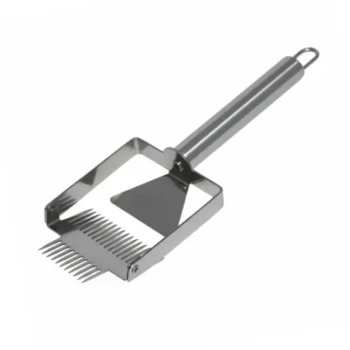At its core, a solar waxer optimizes wax melting by functioning as a highly efficient solar oven. It uses a transparent lid to trap solar radiation, insulated walls to retain the captured heat, and an angled design that leverages gravity to separate the pure, molten wax from impurities.
The device's brilliance lies in its simplicity. It passively harnesses the greenhouse effect to generate temperatures above the 62°C (144°F) needed to melt beeswax, while its internal structure automatically filters and collects the rendered wax.

The Core Principles of a Solar Waxer
A solar waxer is more than just a hot box; its design incorporates several key principles working in concert to achieve an efficient and clean melt. Understanding these principles clarifies why it is such an effective tool for beekeepers.
Capturing Solar Energy
The top of the waxer is a glass or double-web plate lid. This component is critical, as it allows short-wave solar radiation to enter the box freely.
Once inside, this energy is absorbed by the dark combs and the interior surfaces, which then re-radiate it as long-wave thermal energy, or heat. The glass lid is opaque to this longer wavelength, effectively trapping the heat inside.
Maximizing Heat Retention
To prevent the captured heat from escaping, the waxer is built with thick, insulated walls. This insulation is key to reaching and maintaining a temperature high enough to melt wax efficiently.
Without proper insulation, the internal temperature would struggle to rise significantly above the ambient air temperature, making the melting process slow and unreliable.
Leveraging Gravity for Separation
The interior of the waxer is designed with a sloped floor or angled rack. Old honeycombs or wax plates are placed on a mesh screen in the upper part of this slope.
As the wax melts, gravity pulls the liquid wax downwards. It drips through the mesh screen, leaving behind the old cocoons, propolis, and other debris, a substance beekeepers call "slumgum."
Enhancing Purity with Filtration
The mesh screen serves as the first stage of filtration, catching the coarsest impurities.
The molten wax then flows down the angled floor into a collection pan or bucket, which can sometimes contain a finer sieve for additional filtering. This simple, passive process results in very clean, high-quality blocks of yellow beeswax.
Understanding the Trade-offs
While the solar waxer is an elegant solution, it's essential to understand its advantages and limitations to determine if it's the right tool for your specific needs.
Advantage: Sustainability and Safety
The most significant benefit is its zero-cost, environmentally friendly operation. It uses only solar energy, requiring no electricity, gas, or other fuels.
This also makes it inherently safe. With no electrical connections or open flames, the risk of accidents is virtually nonexistent.
Advantage: Optimal Orientation
Many solar waxers are built on a support that allows the entire unit to be rotated and tilted.
This feature enables the operator to orient the waxer directly towards the sun and track its path across the sky, maximizing solar exposure and significantly improving melting speed and efficiency.
Limitation: Weather Dependency
The primary drawback is its complete reliance on strong, direct sunlight. The device is ineffective on cloudy, overcast days and has limited utility during winter months in many climates.
This dependency means wax processing must be scheduled around favorable weather conditions, which can be unpredictable.
Is a Solar Waxer Right for You?
Choosing the right rendering method depends entirely on your scale of operation and priorities.
- If your primary focus is cost-effective and eco-friendly wax processing: A solar waxer is the ideal tool, turning a waste product into a valuable resource with no ongoing energy costs.
- If your primary focus is high-volume, on-demand wax rendering: The weather dependency and batch size may be too limiting, and you should consider an electric or water-jacketed melter.
- If your primary focus is achieving high wax purity with minimal effort: The passive filtration and gentle heating of a solar waxer produce exceptionally clean wax without constant monitoring.
Ultimately, the solar waxer is a powerful and sustainable solution for reclaiming one of the most valuable products of the hive.
Summary Table:
| Feature | Function | Benefit |
|---|---|---|
| Transparent Lid | Traps solar radiation via the greenhouse effect. | Generates high temperatures (>62°C / 144°F) passively. |
| Insulated Walls | Retains captured heat inside the unit. | Ensures efficient and reliable wax melting. |
| Sloped Floor | Uses gravity to separate molten wax from debris (slumgum). | Produces clean, high-quality beeswax automatically. |
| Mesh Screen | Filters out impurities like old cocoons and propolis. | Enhances the purity of the final rendered wax. |
Ready to produce pure beeswax sustainably?
As HONESTBEE, we supply commercial apiaries and beekeeping equipment distributors with the high-quality tools they need to succeed. Our solar waxers are designed for efficiency and reliability, helping you turn a byproduct into a valuable asset with zero energy costs.
Contact our wholesale experts today to discuss your equipment needs and discover how we can support your operation.
Visual Guide

Related Products
- Professional Honey Uncapping Roller for Efficient Harvesting
- Stainless Steel J Hook Hive Tool for Beekeeping
- Professional Dual-End Stainless Steel Hive Tool for Beekeeping
- All-Stainless Steel Pivoting Honey Uncapping Fork for Beekeeping
- Heavy Duty Stainless Steel Frame Cleaner with Plastic Handle
People Also Ask
- What is the purpose of using soap and suds on the roller? Ensure a Clean, Tear-Free Wax Sheet Release
- What is an uncapping fork? A Precision Tool for Efficient Honey Harvesting
- What is uncapping honey? Unlock the Key Step to Efficient Honey Harvesting
- What is an uncapping roller? The Essential Tool for Bee-Centric Beekeepers
- What is an electric heating honey scraper and how does it work? Streamline Your Honey Harvest



















